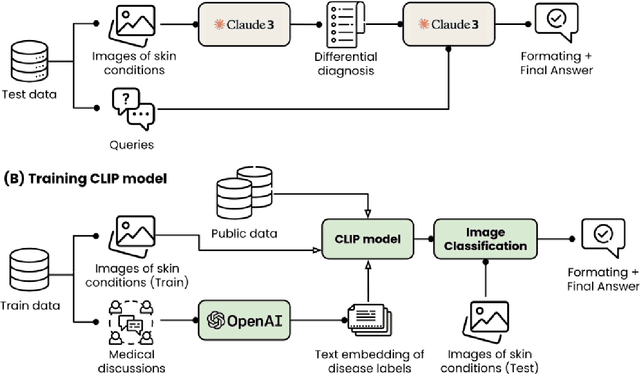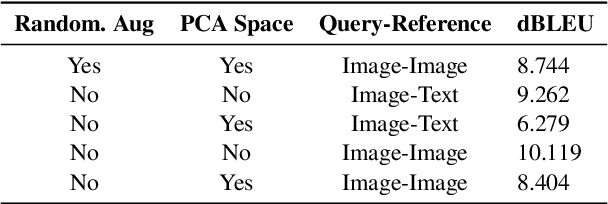Steven Palayew
DarwinAI
WangLab at MEDIQA-M3G 2024: Multimodal Medical Answer Generation using Large Language Models
Apr 22, 2024



Abstract:This paper outlines our submission to the MEDIQA2024 Multilingual and Multimodal Medical Answer Generation (M3G) shared task. We report results for two standalone solutions under the English category of the task, the first involving two consecutive API calls to the Claude 3 Opus API and the second involving training an image-disease label joint embedding in the style of CLIP for image classification. These two solutions scored 1st and 2nd place respectively on the competition leaderboard, substantially outperforming the next best solution. Additionally, we discuss insights gained from post-competition experiments. While the performance of these two solutions have significant room for improvement due to the difficulty of the shared task and the challenging nature of medical visual question answering in general, we identify the multi-stage LLM approach and the CLIP image classification approach as promising avenues for further investigation.
WangLab at MEDIQA-CORR 2024: Optimized LLM-based Programs for Medical Error Detection and Correction
Apr 22, 2024



Abstract:Medical errors in clinical text pose significant risks to patient safety. The MEDIQA-CORR 2024 shared task focuses on detecting and correcting these errors across three subtasks: identifying the presence of an error, extracting the erroneous sentence, and generating a corrected sentence. In this paper, we present our approach that achieved top performance in all three subtasks. For the MS dataset, which contains subtle errors, we developed a retrieval-based system leveraging external medical question-answering datasets. For the UW dataset, reflecting more realistic clinical notes, we created a pipeline of modules to detect, localize, and correct errors. Both approaches utilized the DSPy framework for optimizing prompts and few-shot examples in large language model (LLM) based programs. Our results demonstrate the effectiveness of LLM based programs for medical error correction. However, our approach has limitations in addressing the full diversity of potential errors in medical documentation. We discuss the implications of our work and highlight future research directions to advance the robustness and applicability of medical error detection and correction systems.
PCBDet: An Efficient Deep Neural Network Object Detection Architecture for Automatic PCB Component Detection on the Edge
Jan 23, 2023Abstract:There can be numerous electronic components on a given PCB, making the task of visual inspection to detect defects very time-consuming and prone to error, especially at scale. There has thus been significant interest in automatic PCB component detection, particularly leveraging deep learning. However, deep neural networks typically require high computational resources, possibly limiting their feasibility in real-world use cases in manufacturing, which often involve high-volume and high-throughput detection with constrained edge computing resource availability. As a result of an exploration of efficient deep neural network architectures for this use case, we introduce PCBDet, an attention condenser network design that provides state-of-the-art inference throughput while achieving superior PCB component detection performance compared to other state-of-the-art efficient architecture designs. Experimental results show that PCBDet can achieve up to 2$\times$ inference speed-up on an ARM Cortex A72 processor when compared to an EfficientNet-based design while achieving $\sim$2-4\% higher mAP on the FICS-PCB benchmark dataset.
 Add to Chrome
Add to Chrome Add to Firefox
Add to Firefox Add to Edge
Add to Edge